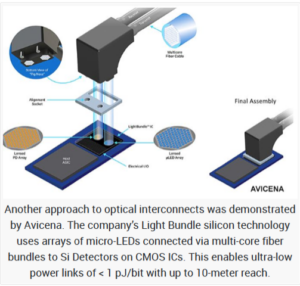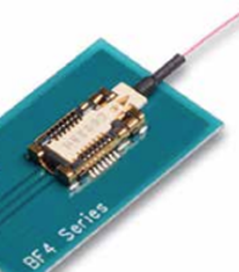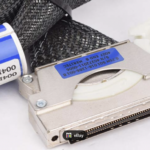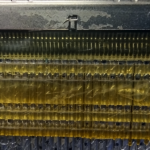Inside-the-box copper connector and cable IO-Link standards for data centers have been a significant focus of systems product development, particularly within consortia and industry standards groups. Some recent examples are internal 400G and 800G PECFF Top-of-Board, Ethernet, CXL, and the PCIe use of SFF TA 1002/1020 connectors. Other examples include twin-axial cables for memory, storage, server, accelerator, and switch Link applications.
The internal optical connectors and cable assembly applications were somewhat less standardized in the past, at least compared to copper types. Many older applications, especially chip-to-optical modules inside wall types, use extremely small, clear, and translucent plastic housings like the fiber-array connector types.
Typically, these separable connectors are straight-angle exit types for edge-mounted applications. These assemblies often use MPO connectors on the other end of short jumper assemblies. Optical passive device manufacturers tend to build their own fiber-array connectors and cables, such as HYC Co Ltd.

Optical fiber manufacturing companies like Corning’s Alliance Fiber Optic Products Division also offer standard Fiber Array Unit (FAU) assemblies that support mature applications.

Corning also offers newer ultra-compact FAUs that leverage its newest reduced-clad bend-insensitive, smaller-diameter fibers. These assemblies support higher-density, fiber-to-chip coupling solutions needed for 51T switches with 800G Links.
Fiber management is an increasing challenge inside newer switch boxes that use 1.6T and 3.2T Links. Some of the newer switches use over 1,000 fibers inside the box, so much smaller fiber core-to-core density is required. To this end, expect even smaller and higher fiber-count connectors soon, which will require increased manufacturing automation.

FAUs have various material types, port counts, fiber types, polished angles, port spacing, FAU thickness, lens options, and hermetic coatings. They also offer smaller connectors using 2, 4, or 8 standards or specialty fibers, which support many traditional IO serial interfaces.
Like other suppliers, Corning offers 8, 16, and 32-V grooves and fiber arrays with cover plate options, such as quartz, Pyrex, and silicon. High-temperature applications often require heat-resistance materials and many newer IO interfaces use 16, 32, and 48 fiber connector products. These arrays are available with pitches of 127um and 250um.
In the future, there will likely be a higher volume of applications and uses for internal fiber-optic connectors and cables compared to copper types. This will lead to more internal fiber-optic connectors and cables becoming standardized.
This article is focused primarily on fiber-to-chip types. A follow-up article will cover mid-board, internal faceplate, and other inside-the-box applications.

A few additional internal applications include:
- Inside the Coherent module
- Inside the OBO module
- Inside the CPO module
- Inside the Accelerator module
- Inside the AOC plug
Teramount’s separable Photonic-Plug optical connectors employ a new assembly process and design to better enable very high-fiber count linear connections. The company’s self-aligning solution is ideal for higher fiber-count applications. It was developed to support wide-band surface coupling for WDM silicon photonic chips.
Here are the technology details:
Senko Advanced Components Inc. offers straight and 90-degree separable plastic optical connectors and cables. The company’s newer ruggedized metalized PIC connector uses moderate-cost micro-mirrors. This connector was developed to handle extreme temperatures and installations.
For instance, it can accommodate 8 fibers in a single row, supporting vertical and edge coupling with low loss. Here’s the technical data:
Driven by newer Silicon Photonics implementations inside both the box and transceiver modules, there are several other upgraded internal fiber-optic connectors. There are also efforts to design new industry-standard optical connectors and cables.
Let’s look at some of the newer internal optical connector products and applications.
LESSENGER’s’ optical polymer jumpers can be used as a one-piece, inseparable jumper-style connector that joins VCSELs with optical cables. This seems like a low-cost component solution.
The image below shows the 90-degree arc polymer fibers bonded with the ribbon fiber cable, which has an MPO-type connector on the other end — an example internal module faceplate connector option. Perhaps they’re used in LESSENGER’s 800G external AOC plug.
Here’s a comparison between the older, more costly mirror technology:
Below are two images showcasing newly available fiber-array connectors with a 90-degree cable, using moderate arc bends and small radius fibers. One application is inside the next-generation CPO switches.
Sumitomo Electric’s latest connector uses BIMM and BISM, with extremely flexible fibers supporting new CPO applications.
Here’s a look at their low-profile connector solution:
Avicena offers multi-core fiber connectors and cable assemblies. This solution supports newer high-lane count transmission applications. One end of the cable can have various types of internal faceplate connectors so as to support different applications.
Another example of a new, single-mode multi-core fiber:
Hirose has a new internal separable active optical module connector and cable assembly product family. Various EO chips are embedded in the plug connector. The low profile, 1.5mm, high BF4 has separable TX and RX modules that are mated post-soldering process. It’s designed for narrow serial interface applications.
The 2 or 4-lane cable typically goes to the faceplate, but it supports chip-to-chip and other chip-to-internal faceplate applications.
Check it out here:
Observations
Inside the module optical connectors, fibers, cable assemblies and production will require ongoing advances to meet process automation demands. Architectural interface Links will likely soon require several more transmission lanes and many more fiber lanes.
The newer multi-lambda fiber and laser chips are currently being used to accommodate several lanes to ensure proper transmission. Ideally, this requires simpler, low-circuit and fiber-count connectors.
Interconnect architects and technical experts must track and compare various roadmaps for each connector type to determine which is most successful for the rapidly advancing data centers of today and tomorrow.
Currently, there are several types of small fibers, including smaller fiber diameters, more flexible BIMM, BISM, multi-core, and hollow-core fibers. This has led suppliers to develop new connectors and ferrule products to support new market segments, data center types, and applications.
It’s likely that some standards groups will need to use some of these new fiber-optic connectors and may specify some. It’s worth following OIF, IEEE-802.3, InfiniBand, IOWN, and UEC (Ultra Ethernet Consortium) for new insights.
Developers will be busy collecting as much comparative information as possible on the latest interconnects, topologies, products, performance, and costs to compete in the future.
For reference, below are images of mid-board and faceplate applications that will be covered in the next article.
It’s important to monitor the next-generation applications and interconnect designs where the external ribbon fiberoptic cables run directly through the box wall and directly connect internally with the transmitting optical transceiver chips. It provides the ideal optical transmission Link path with the lowest loss between boxes and the fewest connector transitions. This solution might optimize the use of hollow fibers directly from chip to chip.



























Leave a Reply
You must be logged in to post a comment.